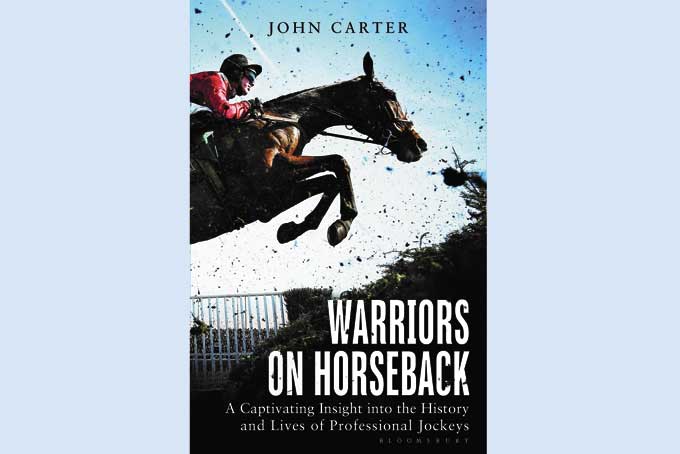
Thirty seconds.
That’s all it took. You barely had time to yell, but that didn’t matter. The ponies racing on the ground below the stands probably couldn’t hear you anyhow, or see you jump for joy. They were too focused on the small humans perched on their shoulders, and on tearing up the dirt. And if the thought of that makes your heart pound like hooves on a racetrack, then read “Warriors on Horseback” by John Carter.
The first thing you might notice as Willie Snaith opens the door to his home is that he’s “a little ‘un.” His just-under-five-foot frame, however, is what gave Snaith his fame: he was once a jump-racing jockey in Great Britain.
“Originally,” says John Carter, “the term jockey meant horse dealer or owner…” back when wealthy owners raced their own steeds. In the 18th century, those owners “began to delegate riding responsibilities to minions” who tended to be small, so the horses carried less weight. Early jockeys wore servants’ garb but in the late 1700s, the wearing of silks and colors became the norm.
Because gambling has always followed the sport of racing, winning jockeys could become rich and famous but life wasn’t easy for them. One of America’s “tragic hero[es] of the time” was African American Isaac Murphy, whose father was a Union Army soldier in the Civil War. Murphy had a special method of getting his mounts across the line first and by the 1880s, that made him “the highest-paid athlete in the USA” with winnings of near $20,000 a year. Alcohol and weight problems plagued him and he died at age 34 of pneumonia; Murphy is buried next to Man o’War at the Kentucky Horse Park in Lexington.
But booze isn’t the only thing that can do a jockey in.
Many jockeys have suffered broken bones and concussions. Since they need to weigh in before every race, “Most feel they have no choice but to almost starve themselves.” Some become bulimic or suffer from depression. All, as Carter indicates, ignore the danger they undertake in the saddle but even that, eventually, seeps into their minds…
For the average North American reader, “Warriors on Horseback” is going to be a big challenge to read—not for what it says, but for what it doesn’t say.
Author Carter includes many facets of horse jockeying here: what it’s like to be a valet, what you’d find in the jockey’s locker room, the dangers of riding an animal that’s easily 12 times your size, and why anyone would do it. There’s a nice overview of the history of jockeying…in Great Britain. And there’s the shortfall: readers will find very little about American or Canadian jockeys or races and almost nothing about the contributions of African Americans or Latino jockeys.
(“Warriors on Horseback” by John Carter, c.2015, Bloomsbury, $30, higher in Canada, 238 pages.)
Follow @NewPghCourier on Twitter https://twitter.com/NewPghCourier
Like us at https://www.facebook.com/pages/New-Pittsburgh-Courier/143866755628836?ref=hl
Download our mobile app at https://www.appshopper.com/news/new-pittsburgh-courier
